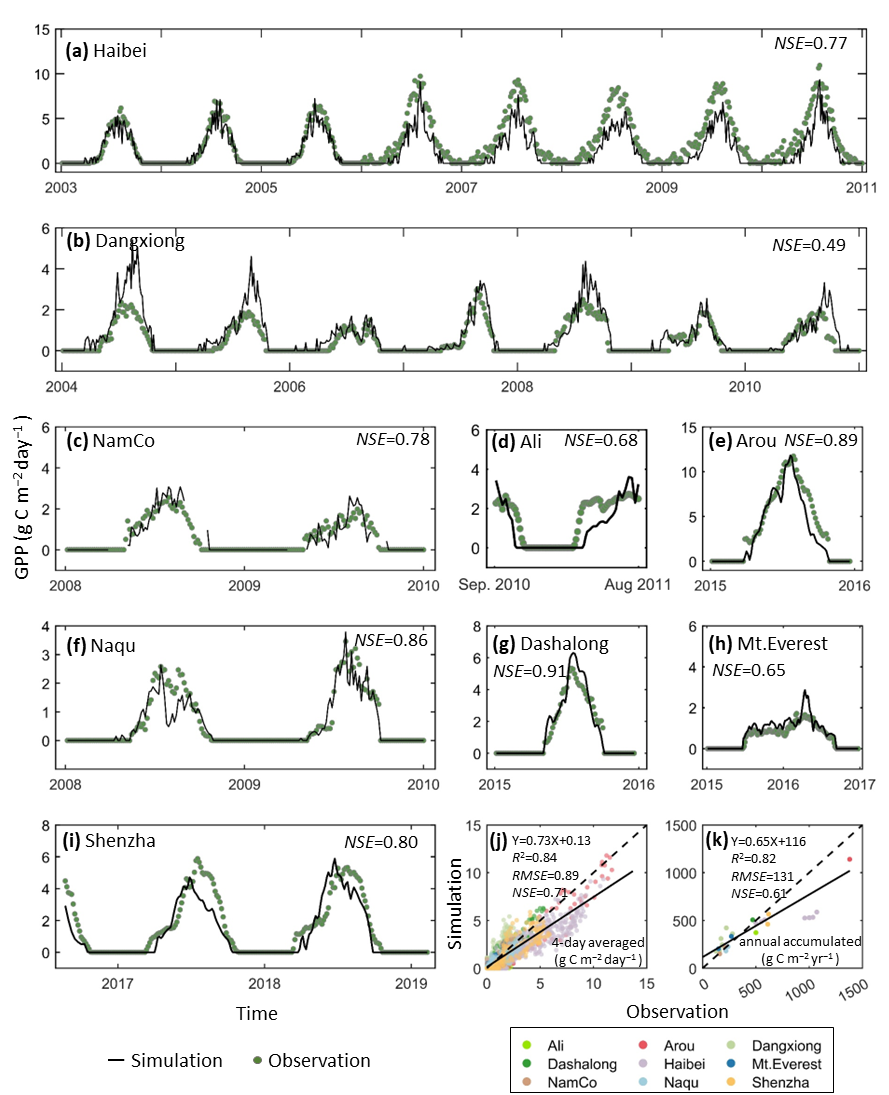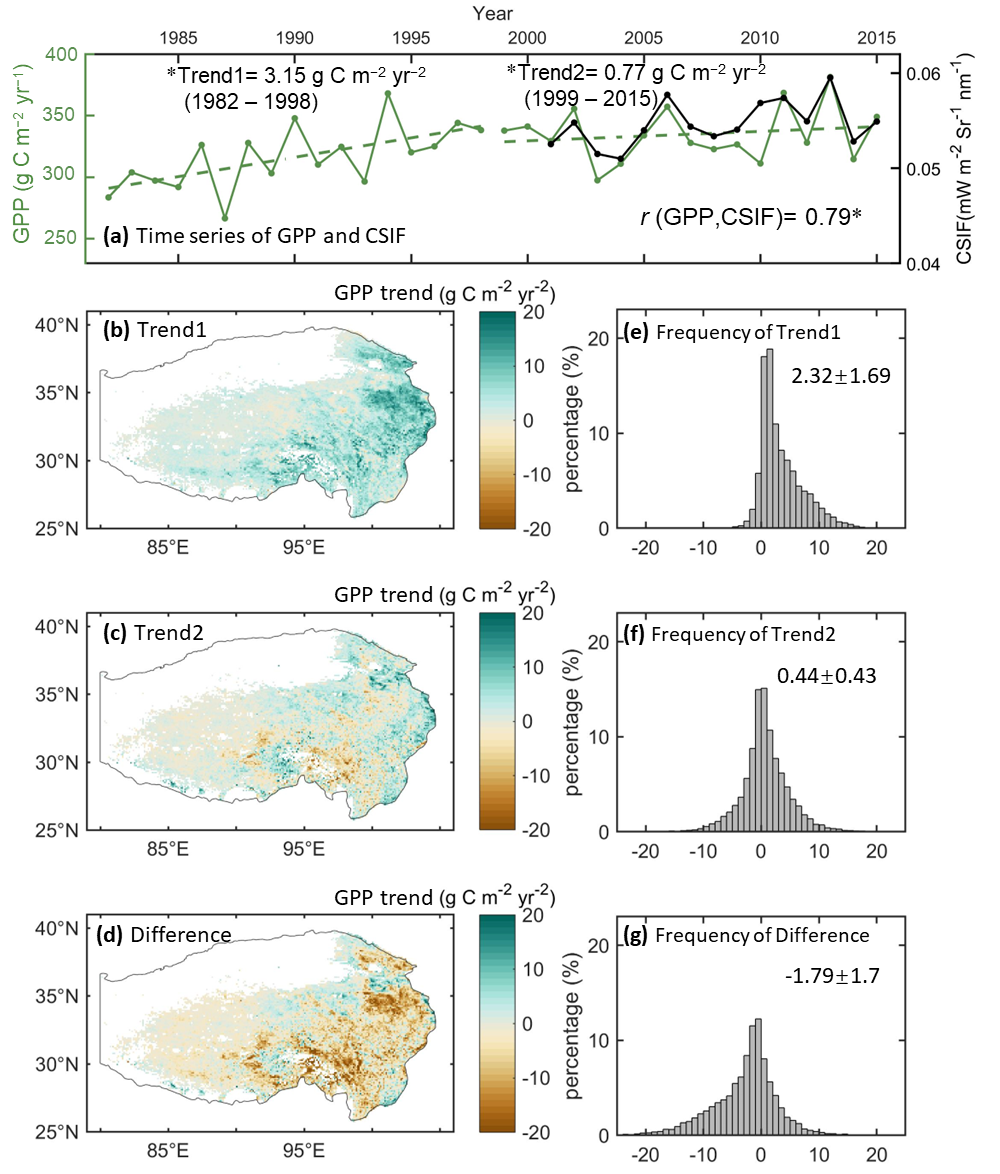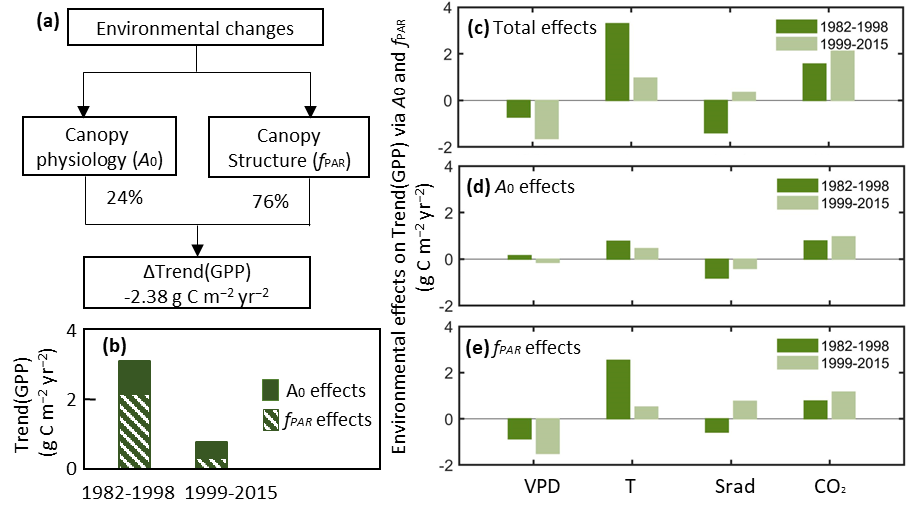Plants absorb CO2 from the atmosphere through their canopy via process of photosynthesis, forming gross primary productivity (GPP), which plays an important role in realizing terrestrial ecosystem carbon sequestration and “carbon neutrality”. The changes of GPP is regulated by environmental changes via the physiological and structural properties of canopies (such as vegetation greenness). The Tibetan Plateau is one of the most sensitive regions to climate change. An important point that remains unclear is whether, and to what the changes of vegetation productivity on the TP are attributed to the green canopy vegetation and/or its physiology. To gain insight into this question, Wang Han’s Research Group of the Department of Earth System Science (DESS), Tsinghua University employs the Productivity model (Pmodel) developed by the Research Group to simulate the vegetation productivity on the TP, discovering that an increasing but weakening trend of GPP at the end of the last century and quantitively analyzing the impact of canopy structure and physiological changes on vegetation productivity for the long-term period. The related research results have been published in a paper titled “Vegetation productivity slowdown on the Tibetan Plateau around the late 1990s” in Geophysical Research Letters.
In the research, first, the simulation effect of Pmodel for GPP in alpine ecosystems on the TP was estimated (Figure 1), discovering that Pmodel can well capture the GPP changes at the flux sites without parameter calibration through comparison with observed GPP data at nine flux sites with different vegetation sites on the TP. The simulated GPP explained 84% of the observed GPP changes, with RMSE and NSE of 0.89 and 0.71 g C m−2 day−1, respectively.

Figure 1 Comparisons between the Pmodel simulated GPP and the observed GPP at nine alpine sites. (a–i) Time series of GPP for all observed years at nine sites, respectively. (j–k) Scatter plots of simulated GPP and observed GPP at nine sites at the 4-day and annual scales, respectively.
The simulation results from 1982 to 2015 show that the increasing trend of GPP on the TP gradually weakened after 1998 (Figure 2). From 1982 to 1998, approximately 90% of the TP area displayed an increasing trend. In contrast, after 1998, a reduced increasing trend was observed in 72% of the TP area compared to the previous period, with a quarter of these regions shifting from a positive to a negative GPP trends.

Figure 2 The GPP trend of the Tibetan Plateau from 1982 to 2015. The spatial distribution of GPP trend during the year of 1982–1998 (Trend1) and 1999 to 2015 (Trend2), and the difference between the two trends (Trend2 minus Trend1).
It has been found in the study that the contribution of canopy structure changes induced by environmental changes to the slowdown of GPP increase trend on the TP far exceeds the impact of canopy physiological properties (Figure 3). It is considered that the structural properties such as vegetation coverage affect the proportion of photosynthetic effective radiation absorbed by the canopy, while the physiological properties determine the maximum potential photosynthetic rate of all photosynthetic effective radiation absorbed by the canopy. Both of them are affected by environmental conditions and jointly regulate the canopy GPP. The weakening of GPP increase trend induced by canopy structure change is mainly influenced by the decrease of temperature rise and the increase of atmospheric dryness. After 1998, although the CO2 fertilization effect was increasing, the decrease of temperature rise rate and the increase of atmospheric dryness obviously inhibited the greening trend, further weakening the increase trend of GPP. The study emphasizes the coupling effect between vegetation productivity and canopy greenness in the TP alpine ecosystem, and further reveals the relationship between climate-carbon feedback on the TP.

Figure 3 Attribution of GPP trends on TP. A0 effect shows the effects of the environment on GPP by changing canopy physiology, fPAR effect shows the effect of the environment on GPP by changing canopy structure, and total effect is the total effect of the environment on GPP by changing both.
Doctoral student Ren Yangfan of Class 2021 of the DESS, Tsinghua Univer is the first author of the paper, and his supervisor Associate Professor Wang Han is the corresponding author. Professor Yang Kun and Associate Professor Li Wei are co-authors. This work was supported by the National Natural Science Foundation of China, among others. The collaborators include researchers from the Institute of Tibetan Plateau Research, Chinese Academy of Sciences and Hainan University, among others.
Full-text link: https://doi.org/10.1029/2023GL103865
Written by Ren Yangfan
Edited by Wang Jiayin
Reviewed by Zhang Qiang